Menu
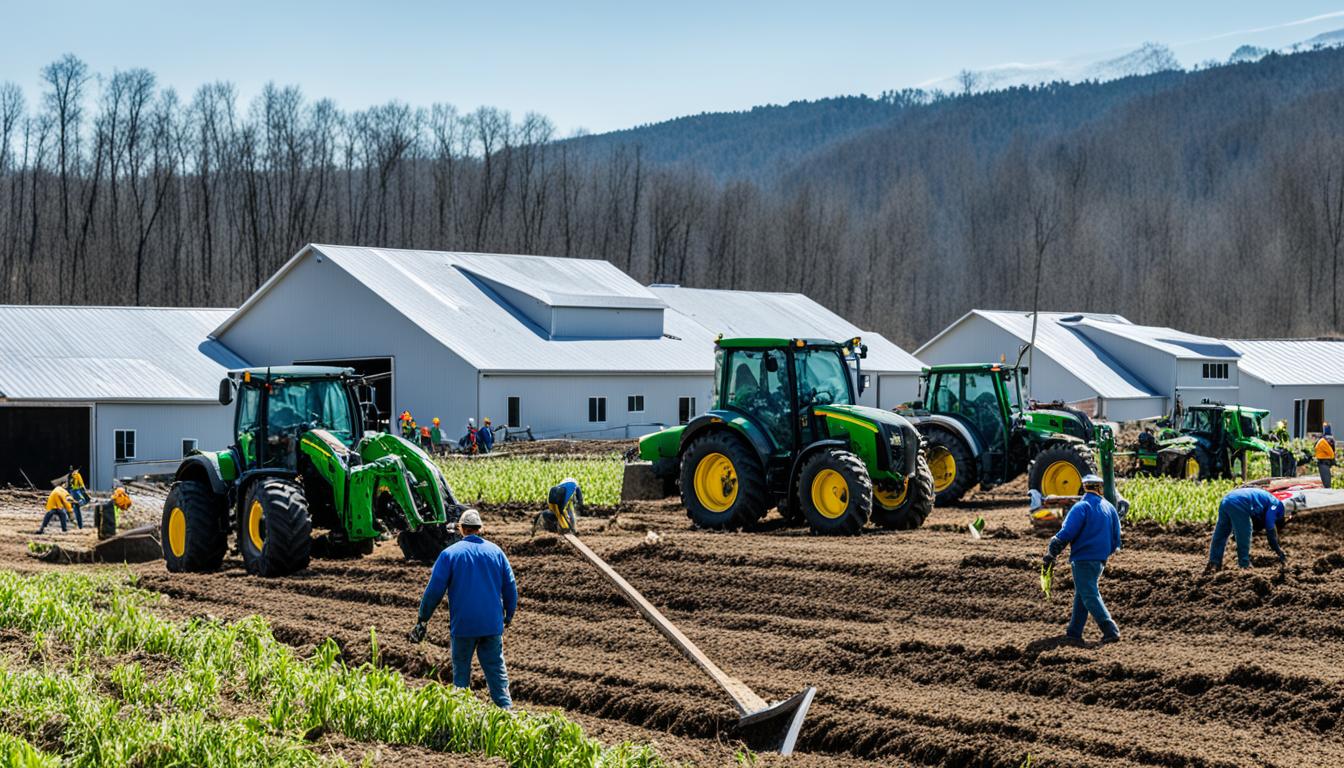
Did you know the Livestock Forage Disaster Program (LFP) can give up to $125,000 for grazing losses due to drought or fire? These big amounts show how important it is to plan for disasters in farming. For farmers like me, getting ready for disaster is a must. It helps prevent risks, keeps the farm business going, and makes sure we can respond well to a farm crisis.
When a disaster hits, having a detailed map of the farm ready can save lives. This map should show buildings, dangerous materials, and the best ways to get in and out. It’s also smart to prepare an emergency kit just for the farm. Include a list of key people to call, like state vets and emergency officials. This is crucial for the first days after a disaster.
We should always check our insurance is up to date for all possible dangers. Proper insurance is key in protecting the farm from big losses. It’s also good to have things like sandbags, fuel, and tools ready. These items can make a huge difference in a crisis. Plus, there are programs that can help with planting new trees or fixing up the land. But, taking bigger steps for overall preparedness is essential.
In farming, disaster recovery planning is key. It protects livelihoods and ensures continuity. This involves knowing the risks, both natural and man-made. Developing solid strategies is essential for farm and rural resilience.
Disaster recovery plans safeguard farms from unpredictable events. A quick response helps farms bounce back, reducing economic loss. Farmers get support from the USDA and the Small Business Administration. With proper planning, rural areas can recover from disasters.
Farmers should be ready for various disasters. These include natural events and disease outbreaks. Here are some examples and how farmers can get help:
| Type of Disaster | Description | Available Support |
|---|---|---|
| Flood | Inundation of agricultural land causing crop and property damage | FSA Emergency Loans, FEMA Disaster Assistance |
| Drought | Extended period of deficient rainfall affecting soil moisture | USDA Drought Assistance, Small Business Admin Loans |
| Fire | Wildfires causing extensive damage to crops and infrastructure | FSA Disaster Aid, insurance claims, IRS tax deductions |
| Biological Threat | Outbreak of disease affecting livestock and crops | FSA Quarantine designation, Plant Protection Act |
For protection, farmers should stay updated on local warnings. Updating emergency kits is also crucial. This keeps farms prepared and speeds up recovery.
Farms need a detailed check for possible dangers. This helps lessen harm and plan better for emergencies. It’s key to spot all types of risks for a strong crisis response.
Bad weather, floods, and droughts can hit farms hard. Looking at guides like the SafetyCulture one on farm hazards is smart. It teaches how to lower these risks. Keeping an eye on the weather helps too.
Chemical spills or fires are big threats too. Farms must have rules for dangerous stuff and train everyone often. This keeps people safe and lowers risks. The Farm Service Agency can also help with money after bad events, making plans even stronger.
Livestock diseases and pests can really hurt farms. Diseases or pests can spread fast and cost a lot of money. Vaccines and watching closely can stop this. Having a good emergency plan is also key for staying strong.
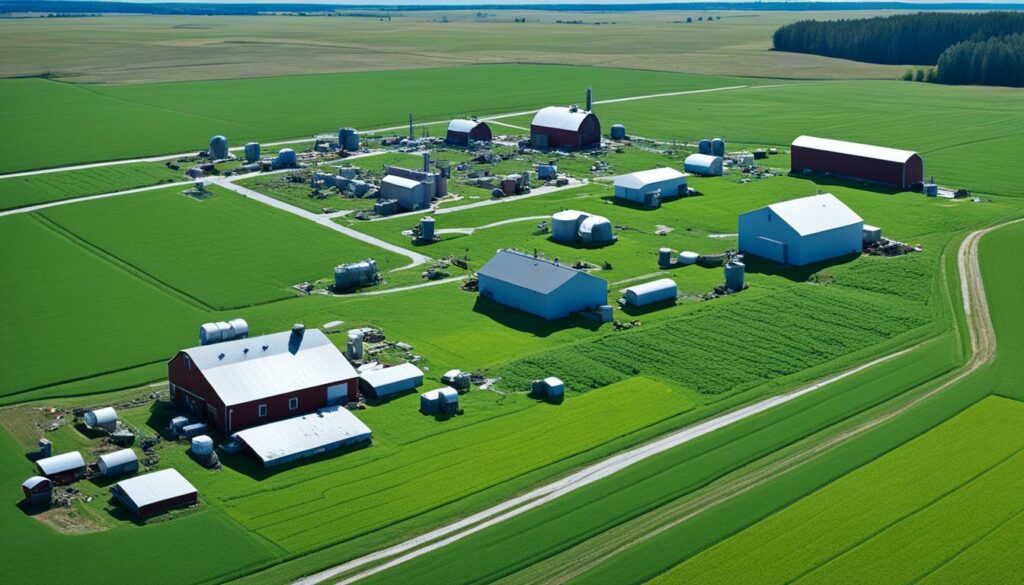
With so many deaths on farms, finding and fixing hazards is vital. Kids are often around these dangers too, so safety must be complete. Spotting dangers early makes farms safer and ready for any emergency.
| Country | Farm Worker Fatalities | Notable Risks |
|---|---|---|
| United States | 23.4 deaths per 100,000 | Vehicle and machinery use |
| Australia | 79 deaths yearly | Highest-risk occupation |
Having a precise farm map boosts disaster recovery for farms. It ensures the farm continues during tough times and lowers risks.
Marking every building on your farm map is key for recovery. This includes barns, sheds, and homes. Knowing these locations helps in emergencies and speeds up resource allocation.
A clear map also shows roads, paths, and obstacles like fences. This helps emergency services move through the farm easily. It cuts response times and makes the farm safer.
It’s important to show on the map where animals and dangerous substances are. This includes where animals graze and where chemicals are stored. Knowing this can prevent big losses and keep things safe in emergencies.
Making a detailed farm map helps a lot when disaster hits. It’s helpful for quick action but also guides long-term risk plans. This way, the farm stays safe and its resources are preserved well.
Emergency preparedness on farms is vital for disaster planning. A good emergency kit improves a farm’s ability to survive disasters. It also makes recovery faster after the disaster.
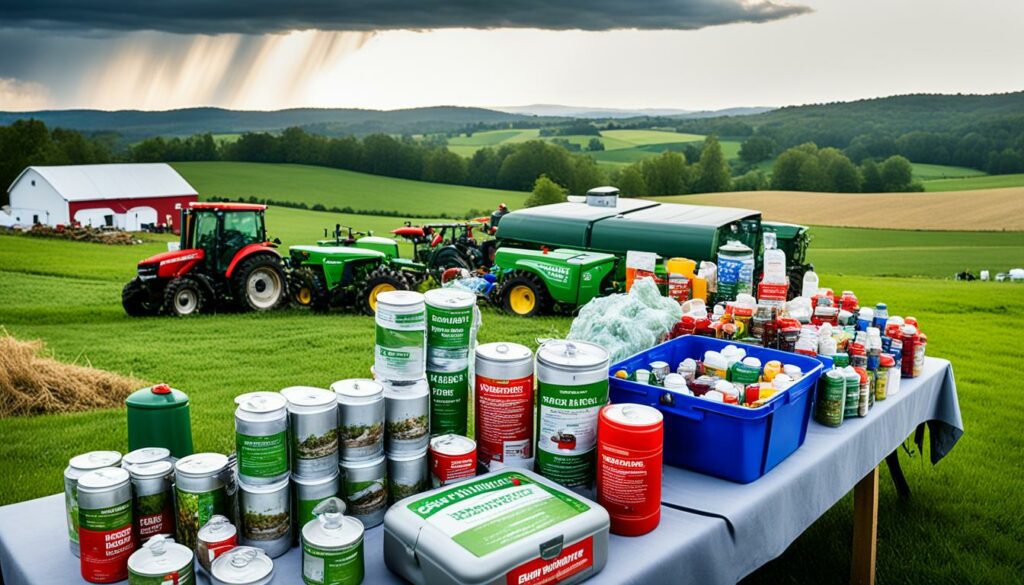
Start building your kit by choosing what items are vital. Your kit should contain:
Research shows not having an emergency kit causes trouble for 63% of those taking care of livestock. Animals in flood areas without a safe spot have a much higher chance of dying. Having the right supplies can protect your farm from big losses and keep it running.
Keeping your kit in good shape is as important as making it. Farms with updated plans are much better at recovering quickly. They have a 60% better chance after an emergency. To update your kit, use these tips:
By keeping your kit up-to-date, you make your farm stronger against disasters. Being ready is key to surviving and recovering well. It also helps your farm’s future safety in emergencies.
In today’s changing farming world, knowing about community warning systems is key. Learning about possible emergencies helps farms act early. This reduces risks and boosts recovery plans. Good community alerts are vital for farm safety.
Having a strong emergency alert system is crucial for every farm. Now, 68% of farmers look to NOAA weather radio alerts first. Yet, just 45% have a clear warning plan for disasters. The EAS and the NWS alerts are important. They give information fast, so farmers can react well.
Community warning channels are very important for farm safety. Most farm disasters are from weather, say 72% of farmers. So, it’s important to use local updates, mobile alerts, and social media for news. Only 36% have a phone tree for contacts, showing we need better plans. Working with local services to improve warnings can help farms a lot.
Here are some numbers to show how ready farmers are:
| Key Area | Percentage |
|---|---|
| Farmers with NOAA weather radio alerts | 68% |
| Farmers with established warning plans | 45% |
| Farmers without an emergency supply kit | 33% |
| Farms without a detailed site map | 56% |
Using community warnings can make farms safer for everyone. Acting early and working together make farms stronger against disasters.
Planning for disasters is vital for farms. It ensures they can bounce back and keep running. The USDA knows farms face many threats. This can be from extreme heat to natural disasters. By planning ahead, farms can react better when these events happen. They work with the USDA to get ready.
The USDA Farm Service Agency has key programs for recovery. For example, ELAP helps farms affected by blizzards or wildfires. It gives support to livestock. Then there’s LFP, offering up to $125,000 for drought or grazing losses. NAP is there for crops hit by earthquakes. Together, these programs are a big help in protecting farms.
FEMA also steps in after disasters. They have different types of aid for people hit by these issues, whether insured or not. They set up Disaster Recovery Centres to make getting help easier.
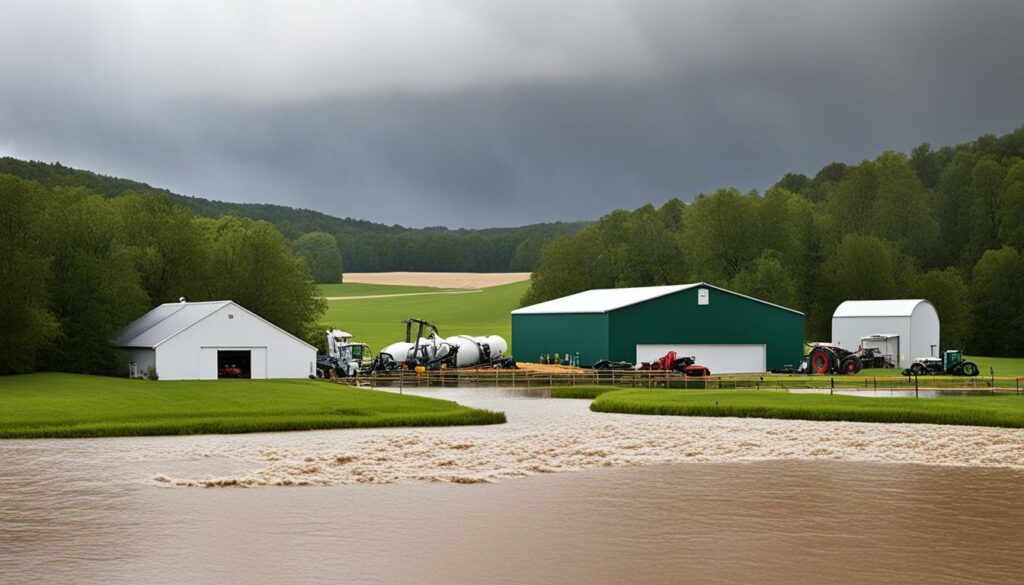
Programs like LIP focus on helping out with livestock losses. Then there’s CRP that offers help during droughts. It’s an important part of recovering after natural disasters.
ECP and EQIP are key for fixing farms and saving water after disasters. And EWP works to stop disasters from happening in the first place. Together, they help farms keep going.
Having these programs in a farm’s emergency plan is smart. It makes for a strong way to deal with crises. Farmers are then better able to keep their farms up and running.
| Program | Type of Aid Provided |
|---|---|
| ELAP | Financial aid for livestock, honey bees, and farm-raised fish affected by adverse conditions |
| LFP | Up to $125,000 for drought or grazing losses |
| NAP | Assistance for non-insurable crops hit by disasters |
| LIP | Financial assistance for livestock loss due to adverse weather events |
| CRP | Emergency haying and grazing for livestock during droughts |
| ECP | Funds for rehabilitating farmland and repairing fences |
| EQIP | Support for water conservation projects |
| EWP | Financial assistance to alleviate watershed threats |
Creating a strong farm emergency plan is key to running farm work during hard times. The plan needs clear roles and tasks for everyone, and ways to talk that help in an emergency. Making sure everyone knows the plan makes dealing with emergencies smoother.
It’s crucial to give everyone on the farm a specific job when disaster strikes. This might be looking after animals, handling dangerous materials, or calling for help. In places like Minnesota, where disasters like tornadoes and floods happen, having a clear farm map is vital. This map shows all key places and helps emergency responders know where to go.
Good communication is essential for keeping the farm running when bad things happen. Using a phone tree helps spread news fast among team members. This system should also lay out what to do if you need to stay put or get out.
Don’t forget about getting ready for health emergencies. Everyone should know what to do if someone gets seriously ill or hurt. And for dangerous situations like gas leaks or being stuck in a grain bin, there must be clear plans. By regularly practising for these emergencies, the farm can react quickly, helping to save lives and prevent damage.
“Almost every farm operation will face a significant emergency situation, such as a farmwork-related injury, fire, or weather disaster. Having an emergency plan can prevent injuries to family members, farm staff, and first responders, reducing potential damage and costs.”
Summing up, having a detailed farm emergency plan is crucial for business as usual during tough times. This can help get insurance deals, too. By practising the plan, every farm member learns how to react in a crisis, protecting people and the farm.
Safeguarding livestock during emergencies is key in *farm emergency preparedness*. Farmers need to act fast to lessen harm to their animals. This boosts *rural disaster resilience* and helps with *disaster recovery planning for farms*.
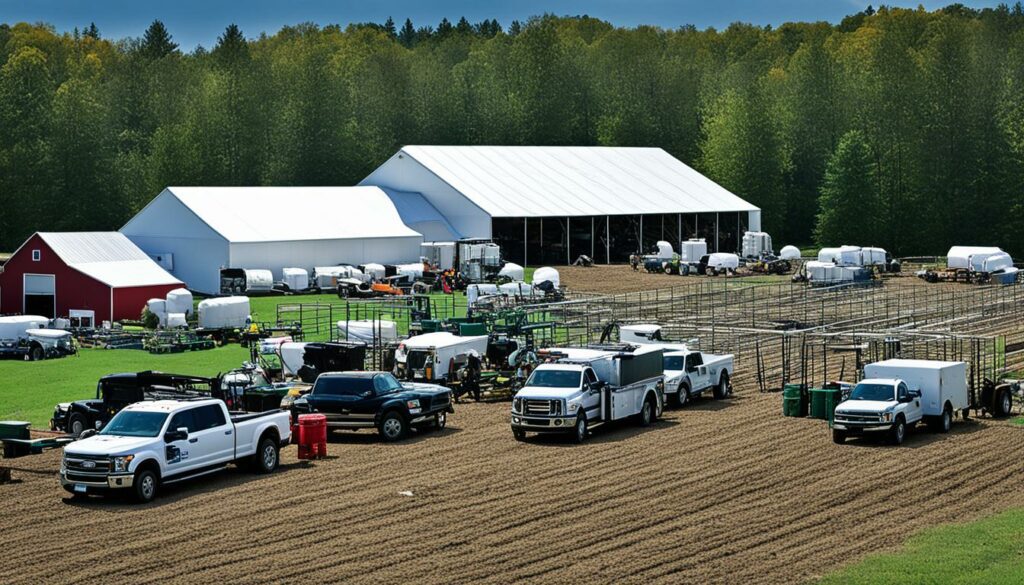
Quick action is vital for keeping livestock safe during a disaster. Every farm should have safe spots these animals can be quickly moved to. This lessens their stress and the risk of getting hurt.
A livestock emergency kit is a must. It should have food, water, and medical supplies. Also, reach out to a neighbour who can help with caring for the animals. Make sure they know how to evacuate them safely.
The FEMA app is handy for getting real-time advice during hazards. It improves how fast and how well you can react.
After a disaster, animal care becomes about healing and upkeep. It’s crucial to work with vets and emergency services to help the animals recover. Farms that check their utilities and facilities right after are able to get back to work quicker.
Feeding and treating the animals come first. This step helps keep the animals healthy. Plus, it makes sure the farm can bounce back well. Such a method helps in *disaster recovery planning for farms* and boosts *rural disaster resilience* overall.
“Having a comprehensive recovery plan not only saves lives but also secures the livelihood of the farming community.”
| Preparedness Measure | Percentage/Figure |
|---|---|
| Farms with a disaster recovery plan in place for livestock | 60% |
| Farms that have identified emergency telephone numbers | 75% |
| Poultry farms with high perches in flood-prone areas | 45% |
| Farms conducting regular safety checks on utilities and facilities | 85% |
| Farms equipped with alternative water and power sources | 50% |
| Farms utilising generators for emergency power | 70% |
| Farms that review and update disaster plans regularly | 55% |
Looking after livestock stretches beyond the immediate disaster. It involves solid planning and continuous care. These steps help farmers reduce the disaster’s bad effects on their farms and animals.
It’s vital to protect crops and plants from disasters for farms to keep running well. Farming faces many threats, and we must be ready with steps to prevent and recover from them. This way, we secure our food sources and the health of our environment.
Being ready before disasters strike is key. Actions like using sandbags can keep crops safe from floods. Choosing crops that can handle bad weather is smart. And using water carefully can help when droughts hit.
The EOSDA Crop Monitoring system spots trouble early with the help of satellite pictures. This lets farmers take quick action to protect their crops.
If disaster hits, quick recovery is a must. Working with insurance can give farmers the money they need to start again. The Tree Assistance Program (TAP) is great for fixing trees, bushes, and vines hurt by disasters.
Other helpful programmes include the Noninsured Disaster Assistance Program (NAP). This helps with crops that insurance won’t cover. And the Emergency Conservation Program (ECP) helps fix farm damage and save water in droughts.
Using all these strategies makes farms more resilient. They help farmers face and bounce back from tough times. By knowing how to prepare and recover, we can keep our food production steady for the long haul.
Keeping equipment and machinery safe is key for managing farm disaster risks. It’s important that all machines are safe from dangers. This helps prevent big losses and keeps the farm running during hard times.
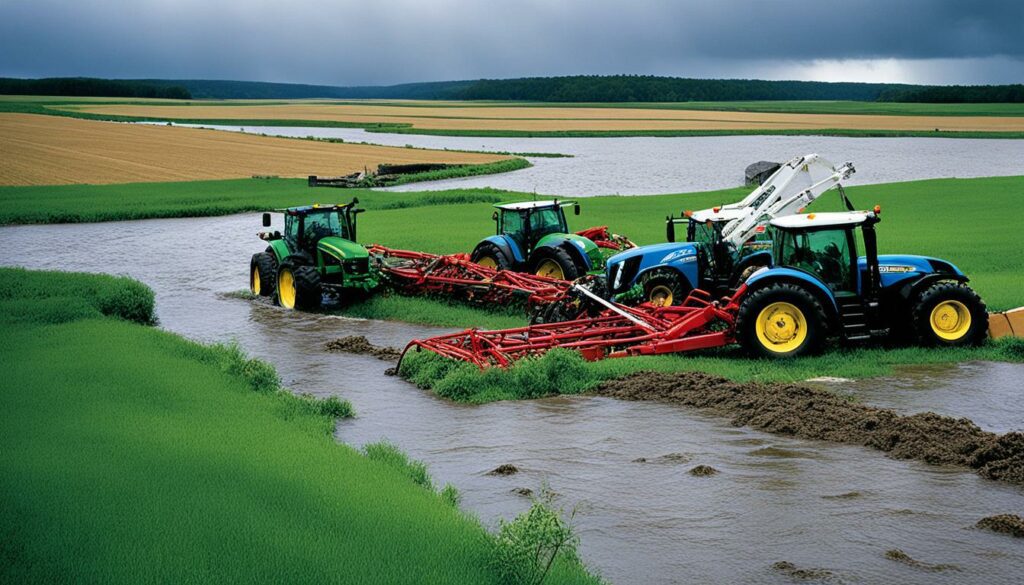
It’s crucial to keep big machines safely placed to avoid emergencies. They should be away from flood areas and spots where fires often start. Putting them on higher ground can shield them from water damage. Many farms have fire extinguishers ready, and some have generators to keep things going even without power.
After a disaster, getting machinery fixed fast is vital. Insurance covering various hazards supports this effort. Also, help is available from recovery aid programs.
Many farms have a lot of animals, showing how important repair is for disaster response.
After a disaster, it’s key for farms to get financial assistance quickly for recovery. Programs like ELAP and the LFP help cover losses from disease and bad weather. The LFP also supports with feed lost to drought or fire.
The LIP helps livestock farmers recover from harmful weather or animal attacks. It makes their road to recovery easier. The ECP fixes farm damage like broken fences from disasters.
The EQIP is for big repairs and disaster recovery improvements. It’s vital for fixing major damage. The EWP provides money to protect people and property when natural disasters strike.
The ACEP changes how land is managed after droughts. It helps keep farms running. The DIPP looks out for dairy farmers by removing bad milk. For those not using CCC loans, the LDPs give financial help.
The Emergency Loan Program and the Emergency Relief Program give needed money for farmers after disasters. Disaster Set-Aside Program helps those with loans by delaying payments in a crisis.
Knowing about and using these programs is vital for farm safety and recovering from disasters. Be sure to know about these helps. They are there to support you and make recovery easier.
Insurance is key to help farms recover from disasters. It’s important to know what farm insurance covers. This includes things like buildings, animals, and everything else against risks.
Farm insurance comes in different types. You can get basic coverage for things like fire. Or, you can get wider coverage for more dangers, like theft or pipes freezing.

The EQIP helps farms improve their land by conserving water. This can help in disaster recovery. The TAP helps orchardists by paying to replant trees after disasters. It shows how insurance and support programs help with risk.
It’s vital to check your insurance regularly. Make sure it still covers what you need. Policies protect things like machinery and buildings. But, you might need extra coverage for specific risks like pollution.
Also, know what each part of your insurance policy talks about. This can help you get benefits quickly if something goes wrong. For example, the LIP helps if you lose more animals than usual due to bad conditions.
Having at least $1 million in liability coverage is often recommended. But, you might need more, depending on your farm’s size and what it does. Always talk to insurance experts and review your policy. This keeps your farm better prepared for disasters.
It’s key to prepare farm staff for emergencies. This helps them deal with tough situations well. Training and clear communication are central for keeping people safe and protecting the farm.
Farm workers need to learn about emergencies and what to do. They should know how to respond in health crises like heart attacks or if someone has an allergic reaction. Teaching them safety rules and doing drills makes sure they can act fast and well.
Knowing what to do in danger is important for keeping the farm running. This means having plans for both staying put or leaving the area.
Make sure these plans are easy to find and understand. Do practice runs to improve how quickly and safely staff can move to safety. An up-to-date map showing escape paths and potential barriers is very helpful.
Also, keep a list of emergency contacts, including vet numbers and local help agencies. Make sure this list is always current.
| Emergency Preparedness Elements | Description |
|---|---|
| Crops and Livestock Inventory | Maintaining detailed lists of all livestock and crops on the farm |
| Emergency Alert Systems | Using systems like NOAA weather alerts, EAS broadcasts via radio, TV, and internet |
| Emergency Supply Kit | Creating and regularly updating a supply kit for emergencies |
| Insurance Coverage | Reviewing with an insurance agent to ensure coverage for all-hazard situations |
| Suppliers and Service Providers | Keeping an updated list of regular service suppliers |
| Emergency Equipment Stockpiling | Stocking essential supplies like sandbags, plastic sheeting, lumber, and hand tools |
Being ready for emergencies and training staff are smart moves. They help a farm keep going during tough times. This protects the business and helps the community bounce back too.
Farms need to prepare well for emergencies by stocking up on important supplies. Some stats show the risk; 70% of farms lose money if they aren’t ready for disasters. Also, 45% of farms don’t have a plan for recovery. Among the key items, having enough fuel and generators is crucial. They help farms keep running during power cuts or when supplies are low.
Generators and enough fuel are vital for working through power cuts. They’re usually good for 72 hours before needing more fuel. It’s smart to service and test generators every two months to make sure they work. Keeping extra fuel means farm machines and other needs can run without stopping. This is an important step in being ready for emergencies on the farm.
Tools and materials are also essential for dealing with damage and recovery. It’s good to have things like hand tools, sandbags, plastic sheeting, wire, rope, lumber, and plywood ready. These items help protect the farm right after a disaster. For example, a farm might have 100 sandbags, 50 feet of plastic sheeting, and essential tools for five people in its stockpile.
Having the right supplies protects farms from troubles and helps them bounce back from disasters. A well-prepared farm can handle unexpected events better. This means farms can keep going and stay successful for a long time.
Disaster recovery plans are vital for farm resilience. They protect the farm’s future during disasters.
Farmers must ready for floods, droughts, and spills. They also prepare for diseases by making solid plans.
Find dangers like severe weather and chemical spills. Also, look out for livestock diseases and pests.
The map should show all buildings and roads. It also marks where livestock and chemicals are, aiding in emergencies.
The kit should have food, fire extinguishers, and water. Also, put tools, fuel, and maps in it. Update it often.
Know about alerts from the Emergency Alert System and NOAA. This helps manage risks and disasters better.
Make a clear plan and assign roles. Use a phone tree for communication. Train your team for emergency actions.
Keep livestock safe and in a known place. After, make sure to contact vets and provide care.
Use sandbags and strong plants to defend crops. After a disaster, work with insurance for a quick recovery.
Keep equipment in safe spots. After a disaster, focus on repairing them to start work soon.
USDA offers help through ELAP, ELRP, LFP, and ECP for losses and recovery. These programs support farmers.
Insurance covers many hazards. Always check if your policy is up to date. This helps get support fast.
Teach staff with drills and clear information. Make an emergency plan and update contacts. This improves the team’s response.
Having enough supplies is key for quick and long-term recovery. Fuel, tools, and materials are essential.